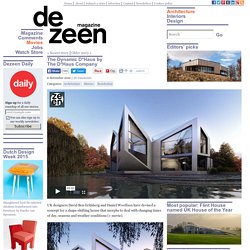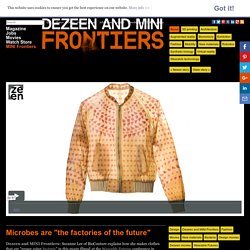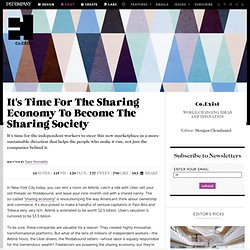

The Dynamic D*Haus by The D*Haus Company. UK designers David Ben Grünberg and Daniel Woolfson have devised a concept for a shape-shifting house that morphs to deal with changing times of day, seasons and weather conditions (+ movie).

Woolfson and Grünberg launched The D*Haus Company to develop the concept for the experimental house, which would fold into different configurations so that it can take on up to eight different shapes. The house was first conceived as part of Grünberg's graduation project. "It was originally devised as a home for Lapland to deal with extreme temperatures," Woolfson told Dezeen. "Not many people know it, but they have warm summers and also really cold winters. " He went on to explain how they've since developed the concept so that the house could be used anywhere in the world. The designers developed the form of the house around the mathematical formula calculated by Henry Dudeney to transform an equilateral triangle into a square, which splits the building into four separate modules.
Microbes are "the factories of the future" says Suzanne Lee. Microbes are "the factories of the future" Dezeen and MINI Frontiers: Suzanne Lee of BioCouture explains how she makes clothes that are "grown using bacteria" in this movie filmed at the Wearable Futures conference in London in December.

"There's a whole spectrum of organisms that can grow material," says Lee, who founded BioCouture to explore how organisms like bacteria, yeast, fungi and algae could be harnessed to produce fabrics. Update: this interview is featured in Dezeen Book of Interviews, which is on sale now for £12. Lee showed the Wearable Futures audience a range of jackets and shoes made from bio-materials produced by bacteria in a vat of liquid to produce bacterial cellulose - a material that has similar properties to leather. "The recipe that I've been exploring to grow a piece of clothing is using a symbiotic mix of yeast and bacteria," she said. She adds: "What attracts me to it is that it's compostable. The music featured in the movie is a track by DJ Kimon. Pinterest. It's Time For The Sharing Economy To Become The Sharing Society. In New York City today, you can rent a room on Airbnb, catch a ride with Uber, sell your old threads on Modabound, and leave your nine-month-old with a shared nanny.

The so-called “sharing economy” is revolutionizing the way Americans think about ownership and commerce. It’s also poised to make a handful of venture capitalists in Palo Alto and Tribeca very, very rich. Airbnb is estimated to be worth $2.5 billion. Uber’s valuation is rumored to be $3.5 billion. To be sure, these companies are valuable for a reason: They created highly innovative, transformational platforms. Of course, that ethos has evolved significantly over the past decade, as the traditional labor structure of a full-time job with benefits has deteriorated. Likewise, the sharing economy is no longer just a creative way for workers to supplement their sagging paychecks in a struggling labor market. There are very few, if any, institutions that freelancers can look to for support. Collaborate or collapse? La maison connectée, reine du salon CES 2014.